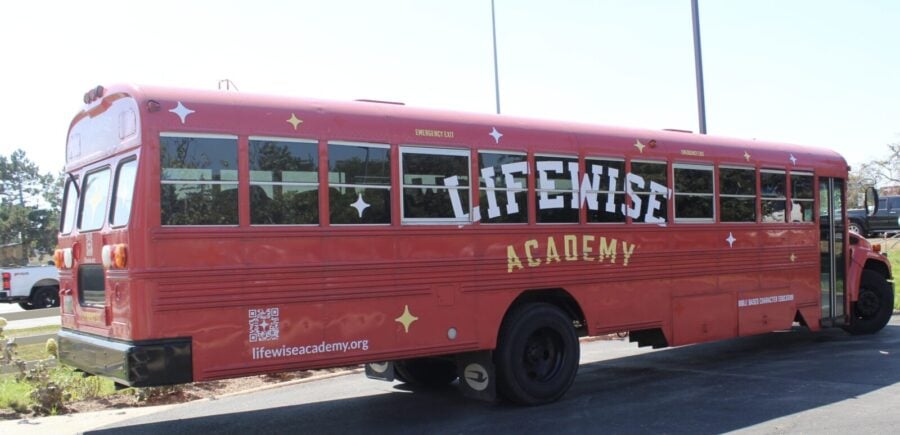
— Megan Henry, used with permission from Ohio Capital Journal
At least nearly a dozen LifeWise Academy Ohio programs have taken public school students on field trips to the Creation Museum and Ark Encounter in Kentucky, which claims humans lived alongside dinosaurs and the Earth is only 6,000 years old.
LifeWise Academy is a controversial Hilliard-based religious instruction program for public school students on “religious release time,” that operates in 34 states and plans to enroll nearly 100,000 students this school year, according to its website.
It will also be in almost half of Ohio’s public school districts this school year.
LifeWise Academy programs in Adams County, Holgate Schools (Henry County), Continental Schools (Putnam County), Antwerp Schools (Paulding County), Wayne Trace Schools (Paulding County), Paulding Schools (Paulding County), Central Local (Defiance County), Van Wert (Van Wert County), and Tinora (part of Northeastern Schools in Defiance County) have all taken field trips to the Ark Encounter this year, in 2024 or 2023, according to Facebook posts from those LifeWise programs. [Central Local is our local school district and we have grandchildren who attend Northeastern Schools]
Pandora-Gilboa’s LifeWise Academy Program (Putnam County) has visited the Creation Museum every year from 2021-2025 and Upper Arlington’s LifeWise Program (Franklin County) visited the museum in 2023, according to Facebook posts from those LifeWise programs.
The Creation Museum promotes young Earth creationism, the belief that God created the universe and everything in it in six 24-hour days 6,000 years ago.
This comes from a literal interpretation of Genesis 1 where God created the universe.
The museum in Petersburg, Kentucky depicts humans and dinosaurs living together and characterizes the Earth as approximately 6,000 years old.
“LifeWise teaches Bible lessons, plain and simple,” Christine Czernejewski, a spokesperson for LifeWise, said in an email. “As such, kids are taught what Genesis 1 actually says — that God created all things and that He created them over the course of 6 different days.” [I bet that children aren’t taught about the divine council or the multiple deities mentioned in Genesis 1-3.]
Scientists have determined Earth is approximately 4.5 billion years old.
“The science (at the Creation Museum), it’s just appalling,” said Daniel Phelps, a retired geologist based in Kentucky.
“They depict dinosaurs and humans as living together. They have many, multiple attacks on the standard view of science, especially things like geology and biology and paleontology. … They misinterpret a lot of the human fossil record, and the Art Park especially has a display that disputes climate science.” [Thanks for speaking the truth, Daniel.]
LifeWise Academy is a non-denominational Christian program [see Letter to the Editor: Lifewise Academy Hides Its Evangelical Beliefs By Saying They Are Non-Denominational] that teaches the Bible to public school students during the school day at a special release time.
“We tend to teach the Bible kind of as it teaches,” said LifeWise Founder and CEO Joel Penton. “We do talk through the six days of creation as outlined in Genesis 1. However, developing a systematic theology of young Earth versus old Earth, we leave that to local churches.” [Most, and I mean MOST, Evangelicals are young earth creationists.]
In January, Ohio Gov. Mike DeWine signed a law passed by Republican lawmakers that mandates public school districts create a policy allowing students release time for religious instruction.
It concerns Phelps that LifeWise programs are taking students to the museum and the ark.
“I would like to call this educational malpractice,” Phelps said. “It simply is not science, and the students are being misled. They’re basically learning to distrust science and follow an extremely fringe version of Christianity.” [Yep.]
A 2019 Gallup poll showed that 40% of U.S. adults believe in creationism, the belief that God created humans in their present form within roughly the past 10,000 years. [actually it it almost 7 in 10 when you add theistic evolution to the equation]
“Most Christians don’t accept the fundamentalist version of creationism,” Phelps said. “… It’s also going to hurt kids that want to have a future studying science and are going to learn all these things that just simply are not true.”
The Creation Museum and the Ark Encounter are both operated by Answers in Genesis, a fundamentalist Christian apologetics organization that promotes young Earth creationism.
The Creation Museum opened in 2007 and the Ark Encounter, 510-foot wooden ship intended as a replica of the biblical Noah’s Ark, opened in 2016.
LifeWise said all field trips require parental permission.
“LifeWise programs have taken field trips to museums, local parks, sporting events and area churches,” Czernejewski said. [Nice dodge. the focus is on trips to an explicitly Evangelical business that promotes science illiteracy.]
Bruce Gerencser, 68, lives in rural Northwest Ohio with his wife of 47 years. He and his wife have six grown children and sixteen grandchildren. Bruce pastored Evangelical churches for twenty-five years in Ohio, Texas, and Michigan. Bruce left the ministry in 2005, and in 2008 he left Christianity. Bruce is now a humanist and an atheist.
Your comments are welcome and appreciated. All first-time comments are moderated. Please read the commenting rules before commenting.
You can email Bruce via the Contact Form.

